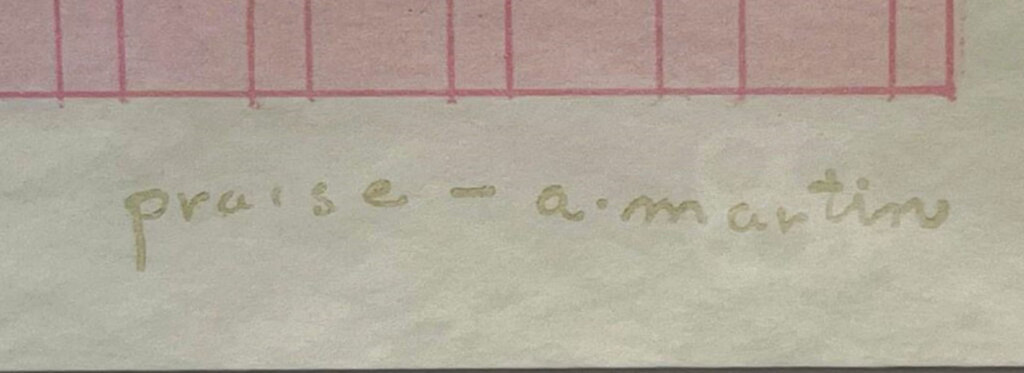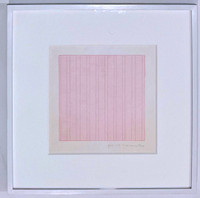
An Educated Collector is Our Best Client
In business for nearly two decades, we are a well established, popular contemporary art boutique specializing in expertly chosen, blue chip prints, multiples, uniques, books, ephemera and merchandise at different price points, with a focus on the secondary market. Please click on the "Contact Us" button at the bottom of this page for questions about any work, pricing and/or to arrange to visit our showroom/gallery - located in between Manhattan's Flatiron and Chelsea Flower Districts.
Description
Agnes Martin
Praise (Framed), 1976
Limited edition lithograph on Dalton Natural Bond paper with gold rubber stamp signature, accompanied by the original sleeve
Agnes Martin's signature is stamped in gold; unnumbered proof
Frame included
Agnes Martin's signature is stamped in gold; an unnumbered proof
This work is accompanied by its original envelope, affixed to the back of the frame
This work was originally distributed by the Museum of Modern Art, New York and is accompanied by the original sleeve, affixed to the back of the frame (see photo)
Frame included: framed in a white wood museum frame with UV plexiglass
Measurements:
Framed
17.75 inches by 17.75 inches by 1.5 inches
Artwork alone
10 inches by 10 inches
"Praise" is an example of Agnes Martin's lifelong fascination with grid-based compositions, which grew from her interest in Taoism. The image is comprised of a light pink square overlaid with a series of darker pink lines, which break the square into columns of alternating widths. The elegant, saccharine pink here is a departure from her typically subdued compositions, which are rarely feature color aside from light washes of muted hues. Martin's use of color here comes after the artist's ten-year respite in the Southwest. This gorgeous pastel-pink lithograph is truly special as it's one of the only prints she did in color. She oversaw every aspect of the prints creation, including the gold stamped signature, which. Despite her close association with the Minimalists, Martin described her work as Abstract Expressionist in line with Rothko's formal logic, “perceptual perfection,” and sparse compositions. She became recognized for her delicate use of lines and sparing application of color. Martin's rubber stamp signature is in gold and is deliberately faint as per the artist's express instructions.
About Agnes Martin:
"Born on a farm in rural Saskatchewan, Canada, Agnes Martin immigrated to the United States in 1932 in the hopes of becoming a teacher. After earning a degree in art education, she moved to the desert plains of Taos, New Mexico, where she made abstract paintings with organic forms, which attracted the attention of renowned New York gallerist Betty Parsons, who convinced the artist to join her roster and move to New York in 1957. There, Martin lived and worked on Coenties Slip, a street in Lower Manhattan, alongside a community of artists—including Robert Indiana, Ellsworth Kelly, and Jack Youngerman—who were all drawn to the area’s cheap rents, expansive loft spaces and proximity to the East River. Harbor Number 1 (1957), one of Martin’s earliest New York paintings, combines the geometric abstraction of her earlier Taos work with the newfound inspiration of the harbor landscape, evident in her choice of blue-gray palette.
Over the course of the next decade, Martin developed her signature format: six by six foot painted canvases, covered from edge to edge with meticulously penciled grids and finished with a thin layer of gesso. Though she often showed with other New York abstractionists, Martin’s focused pursuit charted new terrain that lay outside of both the broad gestural vocabulary of Abstract Expressionism and the systematic repetitions of Minimalism. Rather, her practice was tethered to spirituality and drew from a mix of Zen Buddhist and American Transcendentalist ideas. For Martin, painting was “a world without objects, without interruption… or obstacle. It is to accept the necessity of … going into a field of vision as you would cross an empty beach to look at the ocean.”1
In 1967, at the height of her career, Martin faced the loss of her home to new development, the sudden death of her friend Ad Reinhardt, and the growing strain of mental illness; she left New York, and returned to Taos, where she abandoned painting, instead pursuing writing and meditation in isolation. Her return to painting in 1974 was marked by a subtle shift in style: no longer defined by the delicate graphite grid, compositions such as Untitled Number 5 (1975) display bolder geometric schemes—like distant relatives of her earliest works. In these late paintings, Martin evoked the warm palette of the arid desert landscape where she remained for the rest of her life"
Introduction by Jennifer Harris, Curatorial Assistant, Department of Painting and Sculpture, 2016
Agnes Martin, quoted in Ann Wilson, “Linear Webs,” Art & Artists 1 (October 1966), 48.













